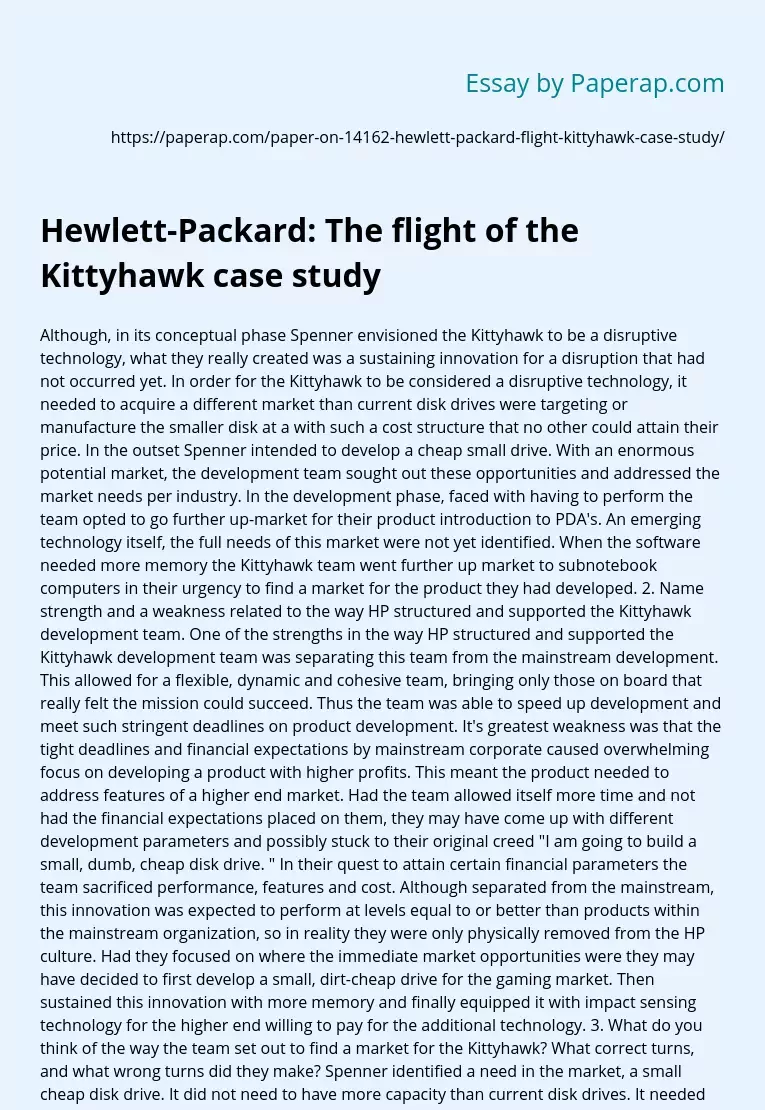Hewlett-Packard: The flight of the Kittyhawk case study
Although, in its conceptual phase Spenner envisioned the Kittyhawk to be a disruptive technology, what they really created was a sustaining innovation for a disruption that had not occurred yet. In order for the Kittyhawk to be considered a disruptive technology, it needed to acquire a different market than current disk drives were targeting or manufacture the smaller disk at a with such a cost structure that no other could attain their price. In the outset Spenner intended to develop a cheap small drive.
With an enormous potential market, the development team sought out these opportunities and addressed the market needs per industry. In the development phase, faced with having to perform the team opted to go further up-market for their product introduction to PDA’s. An emerging technology itself, the full needs of this market were not yet identified. When the software needed more memory the Kittyhawk team went further up market to subnotebook computers in their urgency to find a market for the product they had developed.
2. Name strength and a weakness related to the way HP structured and supported the Kittyhawk development team.
One of the strengths in the way HP structured and supported the Kittyhawk development team was separating this team from the mainstream development. This allowed for a flexible, dynamic and cohesive team, bringing only those on board that really felt the mission could succeed. Thus the team was able to speed up development and meet such stringent deadlines on product development. It’s greatest weakness was that the tight deadlines and financial expectations by mainstream corporate caused overwhelming focus on developing a product with higher profits.
This meant the product needed to address features of a higher end market.
Had the team allowed itself more time and not had the financial expectations placed on them, they may have come up with different development parameters and possibly stuck to their original creed “I am going to build a small, dumb, cheap disk drive. ” In their quest to attain certain financial parameters the team sacrificed performance, features and cost. Although separated from the mainstream, this innovation was expected to perform at levels equal to or better than products within the mainstream organization, so in reality they were only physically removed from the HP culture.
Had they focused on where the immediate market opportunities were they may have decided to first develop a small, dirt-cheap drive for the gaming market. Then sustained this innovation with more memory and finally equipped it with impact sensing technology for the higher end willing to pay for the additional technology. 3. What do you think of the way the team set out to find a market for the Kittyhawk? What correct turns, and what wrong turns did they make? Spenner identified a need in the market, a small cheap disk drive. It did not need to have more capacity than current disk drives.
It needed to be used in smaller simpler technologies that did not require as much memory. The team set out to find the market in all the right places. They identified a slew of applications that the Kittyhawk could be applied to. Two different functions were identified as key features for the drive to have, impact resistance and a cheap drive (note not cost per megabyte). In identifying the different applications that each market could use, the original idea became more complex and larger than the outset. Performance features were added and in their urgency to launch the product one of the key functions of the drive was sacrificed: cost.
4. What do you think are the root causes of the failure of the Kittyhawk program? The root cause of the failure of the Kittyhawk program was that although placed outside the mainstream organization, it was still expected to perform as a product within the mainstream organization. Had the urgency to meet financial expectations not been as high, the development team may have focused more on the key job-to-do that the market was expecting from the drive instead of searching for a market that would meet the financial expectations placed on the Kittyhawk.
Hewlett-Packard: The flight of the Kittyhawk case study. (2018, Feb 09). Retrieved from https://paperap.com/paper-on-14162-hewlett-packard-flight-kittyhawk-case-study/

